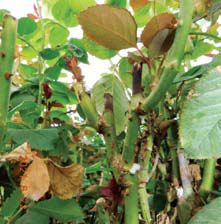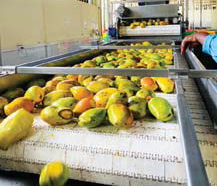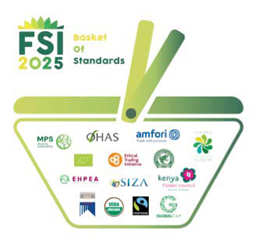Featured Past Articles
Mealybugs pose a serious threat to growers in warmer climates as they can significantly reduce the productivity and yield of greenhouse crops. But lessons-learnt from greenhouse rose farms in Kenya demonstrate that it is possible to manage Mealybugs when the right tactics are deployed, such as early intervention supported by an effective scouting system, writes Edwin Kiptarus and Simon Kihungu
 Mealybugs have taken on a renewed significance with the recent arrival and rapid spread in Kenya of the Papaya mealybug, Paracoccus marginatus. Although not the same species as the Coffee mealybug, Planococcus kenyae, generally found on roses in Kenya, both are quarantine pests that have the potential to spread viruses along fresh cut flower pathways. Other Species of Mealybugs that affects ornamentals are: Common examples include the long tailed mealybug (Pseudococcus longispinus), which has characteristically long waxy filaments that protrude from the end of the abdomen, and the obscure mealybug (Pseudococcus viburni), which also has waxy filaments, but they are much shorter in comparison to the longtailed mealybug. Citrus mealybug (Planococcus citri), lacks any waxy filaments and has a gray stripe that extends the length of the body. The differences are shown in the image below:
Mealybugs have taken on a renewed significance with the recent arrival and rapid spread in Kenya of the Papaya mealybug, Paracoccus marginatus. Although not the same species as the Coffee mealybug, Planococcus kenyae, generally found on roses in Kenya, both are quarantine pests that have the potential to spread viruses along fresh cut flower pathways. Other Species of Mealybugs that affects ornamentals are: Common examples include the long tailed mealybug (Pseudococcus longispinus), which has characteristically long waxy filaments that protrude from the end of the abdomen, and the obscure mealybug (Pseudococcus viburni), which also has waxy filaments, but they are much shorter in comparison to the longtailed mealybug. Citrus mealybug (Planococcus citri), lacks any waxy filaments and has a gray stripe that extends the length of the body. The differences are shown in the image below:
Read more: Mealybugs: Early Intervention is Key to Avoid a Costly Infestation
 Makueni is the leading county in mango production contributing up to 31 per cent of the total fruits that Kenya produces. “Right now the amount exported is two per cent of the total production of 184,000 tonnes produced annually, which is a small fraction,” said Robert Kisyula, the then CEC Agriculture, Makueni.
Makueni is the leading county in mango production contributing up to 31 per cent of the total fruits that Kenya produces. “Right now the amount exported is two per cent of the total production of 184,000 tonnes produced annually, which is a small fraction,” said Robert Kisyula, the then CEC Agriculture, Makueni.
That mangoes are critical to the economy of Makueni County, is not in doubt. What is worrying is that the devolved unit only exports a paltry two per cent to the world market, missing out on lucrative global business.
Part of the reason for a slow uptake on the export market was because of a selfimposed ban by Kenya in 2010 after experiencing a bout of mango fruit fly that risked Kenya’s produce being banned in Europe, which is its main market before the moratorium. “It was easier to pull out ourselves than being banned by markets in Europe. We hope that we will be able to reopen the EU market this year,” he said.
Read more: Hope for mango farmers as exports to Europe resume
 In the run-up to Mother’s Day, Royal FloraHolland could not only report on the good turnover on our market place, but could even report a week record turnover of over 170 million euros. This is partly thanks to the clock. The average price of cut flowers went through the ceiling. The share of the clock has declined in small steps in recent years to 40% last year. But cut flowers are still for the most part traded on the clock. The clock share of cut flowers in terms of turnover is 60% and in terms of volume 54%. This shows that the prices for cut flowers are higher on the clock than in the direct streams.
In the run-up to Mother’s Day, Royal FloraHolland could not only report on the good turnover on our market place, but could even report a week record turnover of over 170 million euros. This is partly thanks to the clock. The average price of cut flowers went through the ceiling. The share of the clock has declined in small steps in recent years to 40% last year. But cut flowers are still for the most part traded on the clock. The clock share of cut flowers in terms of turnover is 60% and in terms of volume 54%. This shows that the prices for cut flowers are higher on the clock than in the direct streams.
 UPL Ltd has continued to deliver successful product innovations. This time they organised a very successful virtual training on Vacciplant, an innovative Biofungicide against powdery mildew in Ornamental crops and Snowpeas. Timely and almost audio-recorded voice of Lara Ramaekers, a UPL Biosolutions Specialist, greeted the air as she took growers through the innovation.
UPL Ltd has continued to deliver successful product innovations. This time they organised a very successful virtual training on Vacciplant, an innovative Biofungicide against powdery mildew in Ornamental crops and Snowpeas. Timely and almost audio-recorded voice of Lara Ramaekers, a UPL Biosolutions Specialist, greeted the air as she took growers through the innovation.
Speaking to the growers Lara asked, “Have you ever thought of protection against powdery mildew without residue?” Adding, “We are discussing the newest technologies in protection against powdery mildew and other causal pathogens. It allows the grower to reduce the number of active ingredients used, achieve better.
Key Benefits
Through the Vaccine action, Vacciplant prompts the plant to fight against the diseases. The product is better used preventively. Lara told the growers that the product has control of various fungal and bacterial diseases with zero residue (0 days PHI). The product poses minimal risk of development of resistance. She confirmed that the product is compatible with both conventional and other biological products. It has no harm to any beneficial organisms and has a unique mode of action. (FRAC Group P4). The product has been approved for organic farming by Ecocert. Vacciplant is also a great tool for successful Integrated Pest Management programs. It is one of the best alternatives for the most demanding food chains and organic growers. It is a complimentary solution to conventional plant protection products.
Read more: Vacciplant: Innovative Fungicide Against Powdery Mildew
 Like many industries, floristry and floriculture are rapidly evolving as technology and farming practices further evolve in the 21st Century. Below are key floristry and floriculture industry statistics and trends highlighting the shifts in production, employment, consumer sentiment, and floristry practices globally. In addition, the impact of Covid-19 will present numerous short term and long-term challenges to the industry as a whole.
Like many industries, floristry and floriculture are rapidly evolving as technology and farming practices further evolve in the 21st Century. Below are key floristry and floriculture industry statistics and trends highlighting the shifts in production, employment, consumer sentiment, and floristry practices globally. In addition, the impact of Covid-19 will present numerous short term and long-term challenges to the industry as a whole.
 Starting 1 January 2021, the FSI Basket of standards has a third scope. The GAP and Social scopes are complemented with an Environmental scope. With IPM and reliable record keeping at the centre, this new scope will offer growers and their supply chain partners capacity to keep the sector future-proof.
Starting 1 January 2021, the FSI Basket of standards has a third scope. The GAP and Social scopes are complemented with an Environmental scope. With IPM and reliable record keeping at the centre, this new scope will offer growers and their supply chain partners capacity to keep the sector future-proof.
It has become evident that reliable record keeping is essential to measure and demonstrate sustainable progress and positive impacts. As new tools like environmental impact indicators and footprints become more widely used, such as the one being developed by FSI, there is urgency to put record keeping in the scope of the FSI Basket. This will offer producers more opportunities to keep their toolbox full, and to proactively demonstrate and discuss with NGO’s, legislators and customers, while remaining the owner of their data.
Floriculture sector is generating higher income and employment opportunities, promoting domestic market and exports. The traditional flower crops grown for loose flowers under open field conditions have different nutrient requirements compared to cut flower crops like roses which are grown under protected conditions. One of the factors affecting the productivity of most of the floricultural crops is due to improper use of nutrients. To improve the productivity, adequate amount of fertilisers in balanced proportion should be used.
Integrated Nutrient Management (INM) including use of mulches, organic manures and bio-fertilisers along with appropriate dosage of fertilisers is cost effective method to achieve more yield and better quality crop, besides, improving the soil fertility.


